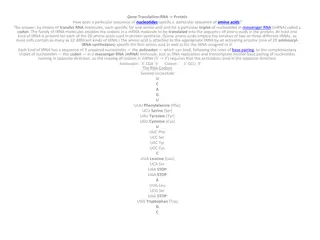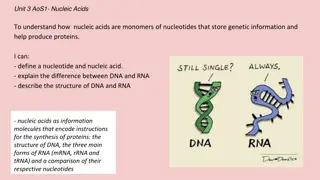Posttranscriptional Modification of RNA Overview
A primary transcript is the initial RNA copy of a transcription unit, subject to posttranscriptional modifications like cleavage and further alterations to form functional tRNAs, rRNAs, and mRNAs. In eukaryotic cells, pre-rRNAs and pre-tRNAs undergo processing by ribonucleases to yield mature RNA species, while eukaryotic mRNA undergoes extensive co- and posttranscriptional modifications. The process involves the removal of introns, alternative splicing, capping with 7-Methyl-guanosine, and addition of poly-A tails. This comprehensive overview discusses the intricate mechanisms involved in RNA modifications across different RNA types.
Download Presentation

Please find below an Image/Link to download the presentation.
The content on the website is provided AS IS for your information and personal use only. It may not be sold, licensed, or shared on other websites without obtaining consent from the author.If you encounter any issues during the download, it is possible that the publisher has removed the file from their server.
You are allowed to download the files provided on this website for personal or commercial use, subject to the condition that they are used lawfully. All files are the property of their respective owners.
The content on the website is provided AS IS for your information and personal use only. It may not be sold, licensed, or shared on other websites without obtaining consent from the author.
E N D
Presentation Transcript
A primary transcript is the initial, linear, RNA copy of a transcription unit the segment of DNA between specific initiation and termination sequences. The primary transcripts of both prokaryotic and eukaryotic tRNA and rRNA are posttranscriptionally modified by cleavage of the original transcripts by ribonucleases. tRNAs are then further modified to help give each species its unique identity. In contrast, prokaryotic mRNA is generally identical to its primary transcript, whereas extensively modified both co- and posttranscriptionally. eukaryotic mRNA is
A. Ribosomal RNA rRNAs eukaryotic cells are generated from long precursor molecules called pre-rRNAs. The 23S, 16S, and prokaryotes are produced from a single pre-rRNA molecule, as are the 28S, 18S, and 5.8S rRNA of eukaryotes. The pre-rRNAs ribonucleases to yield intermediate- sized pieces of rRNA, which are further processed (trimmed by exonucleases and modified at riboses) to produce the required RNA species. of both prokaryotic and o 5S rRNA of o are cleaved by o some bases and Posttranscriptional processing of eukaryotic ribosomal RNA by ribonucleases (RNases).
B. Transfer RNA A. Primary tRNA transcript. B. Functional tRNA after posttranscriptional modification. Modified bases include D (dihydrouracil), (pseudouracil), and m, which means that the base has been methylated.
Both eukaryotic and prokaryotic tRNA are also made from longer precursor molecules that must be modified. Sequences at both ends of the molecule are removed and, if present, an intron is removed from the anticodon loop by nucleases. o o
C. Eukaryotic mRNA The collection of all the primary transcripts synthesized in the nucleus by RNA polymerase II is known as heterogeneous nuclear RNA (hnRNA). The pre-mRNA components of hnRNA undergo extensive co- and posttranscriptional modificationin the nucleus. These modifications usually include: 1. 5 - Capping: 7-Methyl-guanosine 2. 3 - Poly-A tail addition 3. Removal of introns 4. Alternative splicing of mRNA molecules
1. 5- Capping: 7-Methyl-guanosine oThe cap is a 7-methylguanosine attached backward to the 5'-terminal end of the mRNA, forming an unusual 5' 5'triphosphate linkage. oCreation of the cap requires removal of the phosphate from the 5 -triphosphate of the premRNA, followed by addition of GMP guanylyltransferase. oMethylation of this terminal guanine occurs in the cytosol, and is catalyzed by guanine-7- methyltransferase. S-adenosylmethionine is the source of the methyl group Additional methylation steps may occur. oThe addition of this 7-methylguanosine cap helps stabilize the mRNA, and permits initiation of translation. oEukaryotic mRNAs lacking the cap are not efficiently translated. (from GTP) by the nuclear enzyme
2. 3- Poly-A tail addition Most eukaryotic mRNA have a chain of 40 200 adenine nucleotides attached to the 3'-end. This poly-A tail is not transcribed from the DNA, but rather is added after transcription by the nuclear enzyme, polyadenylate polymerase, using ATP as the substrate. The mRNA is cleaved downstream of a consensus sequence, called the polyadenylation signal sequence (AAUAAA), found near the 3'-end of the RNA, and the poly-A tailis added to the new 3'-end. These tails help stabilize the mRNA, facilitate its exit from the nucleus, and aid in translation. After the mRNA enters the cytosol, the poly-A tail is gradually shortened.
3. Removal of introns Maturation of eukaryotic mRNA usually involves the removal of RNA sequences (introns, or intervening sequences), which do not code for proteinfromthe primary transcript. The remaining coding sequences, the exons, are joined together to form the maturemRNA. The process of removing introns and joining exons is called splicing. The molecular complex that accomplishes these tasks is known as the spliceosome. A few eukaryotic primary transcripts contain no introns, for example, those from histone genes. Others contain a few introns, whereas some, such as the primary transcripts for the chains of collagen, contain more than 50 intervening sequences that must be removed before mature mRNA is ready for translation.
Splicing. snRNP = small nuclear ribonucleoprotein particle.
4. Alternative splicing of mRNA molecules The pre-mRNA molecules from some genes can be spliced in alternative ways tissues. This produces multiple variations of the mRNA and, therefore, of its protein product. This appears to be a mechanism for producing a diverse set of proteins from a limited set of genes. Alternative splicing: A diverse set of proteins from a small set of genes in different
Posttranscriptionally modified by cleavage of the original transcripts by ribonucleases. rRNA of both prokaryotic and eukaryotic cells are synthesized from long precursor molecules called preribosomal RNA. These precursors are cleaved and trimmed by ribonucleases, producing the three largest rRNA, and bases and sugars are modified. Eukaryotic 5S rRNA is synthesized by RNA polymerase III , and is modified separately. Prokaryotic mRNA is generally identical to its primary transcript, whereas eukaryotic mRNA is extensively modified co- and posttranscriptionally. Most eukaryotic mRNAs also contain intervening sequences (introns) that must be removed to make the mRNA functional. Their removal, as well as the joining of expressed sequences (exons), requires a spliceosome composed of small, nuclear ribonucleoprotein particles that mediate the process of splicing. Eukaryotic mRNA is monocistronic, containing information from just one gene. Prokaryotic and eukaryotic tRNA are also made from longer precursor molecules. If present, an intron is removed by nucleases, and both ends of the molecule are trimmed by ribonucleases. A 3'-CCA sequence is added, and bases at specific positions are modified, producing unusual bases.























